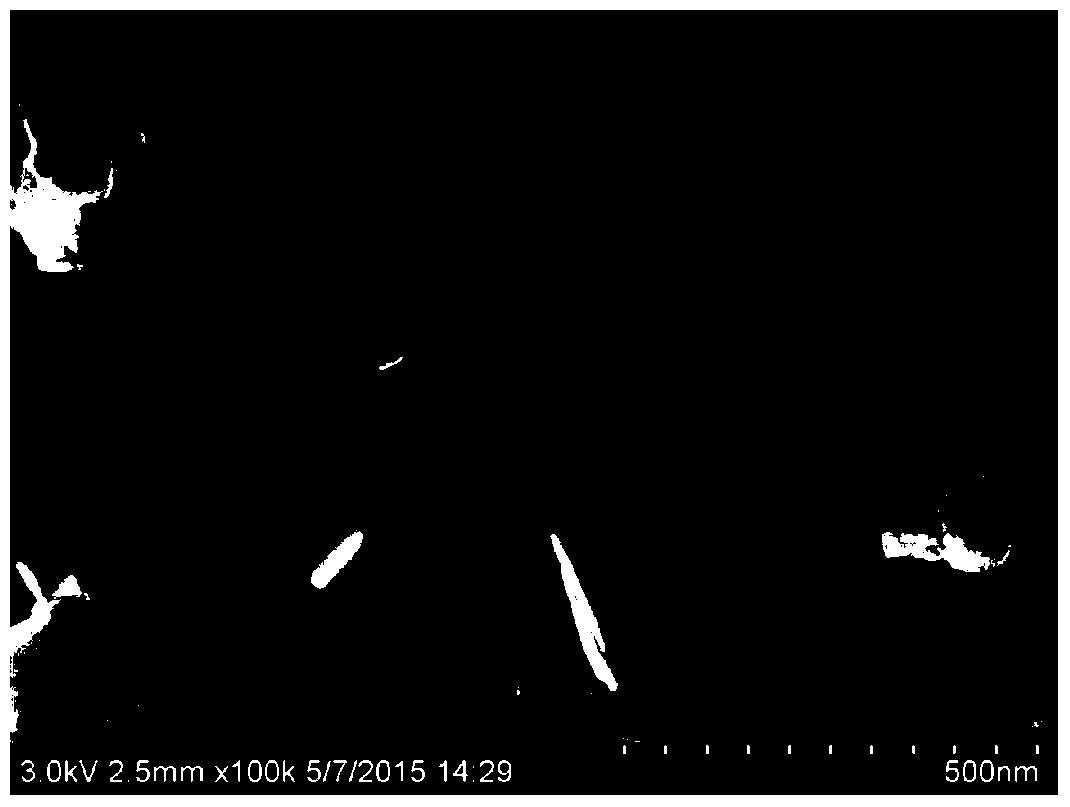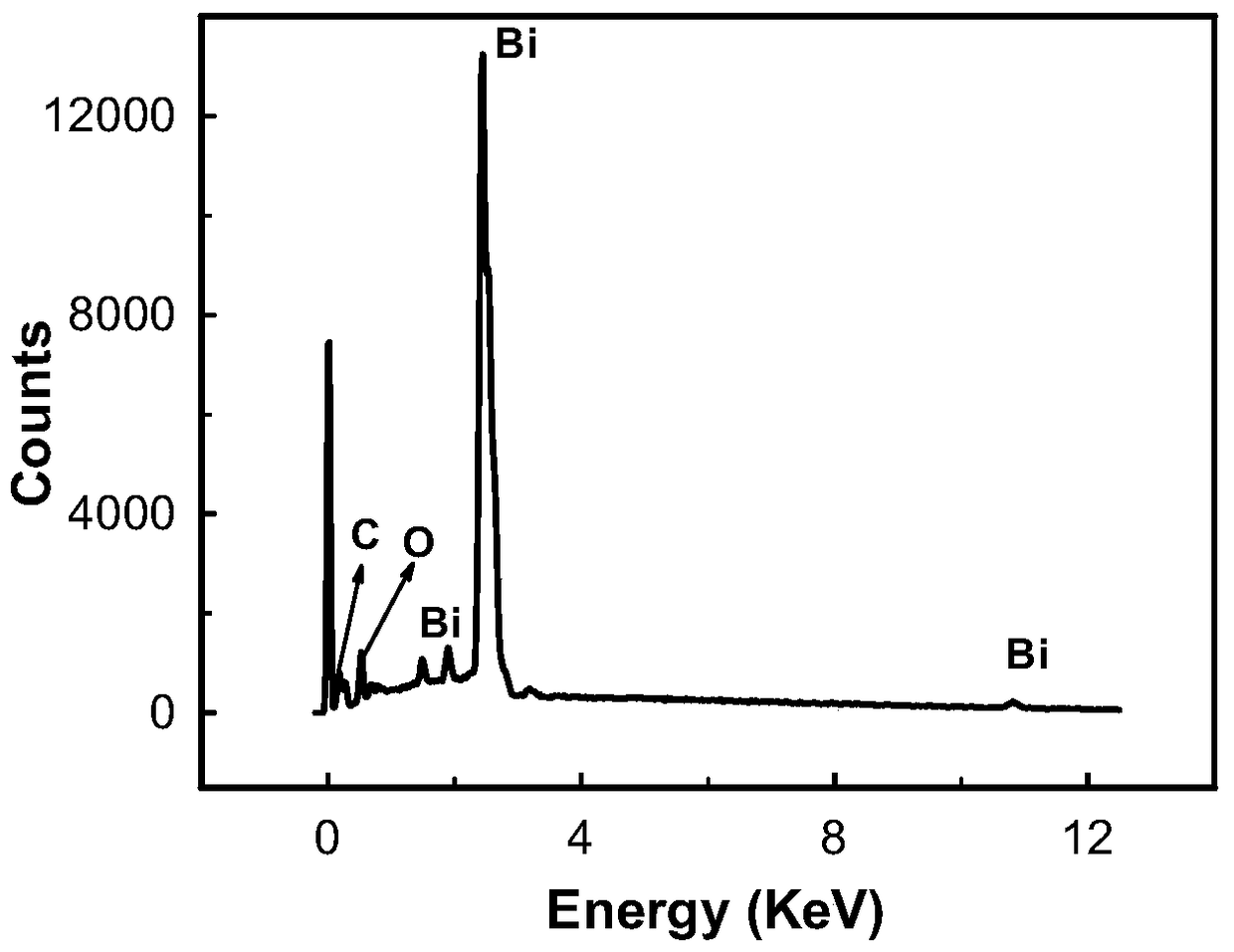A kind of metal nanomaterial and its synthesis method using carbon-based material as template
A carbon-based material, metal nanotechnology, applied in nanotechnology, material electrochemical variables, metal material coating process, etc., to achieve mild reaction conditions, improve analysis and detection performance, and improve the effect of electrode performance
- Summary
- Abstract
- Description
- Claims
- Application Information
AI Technical Summary
Problems solved by technology
Method used
Image
Examples
Embodiment 1
[0027] Synthesis of novel bismuth nanomaterials using graphene as a template and hydrohydrazine as a reducing agent:
[0028] Prepare 1-20mmol bismuth nitrate solution with deionized water, then add a small amount of graphene as a template material to the solution and stir and mix evenly, after that, quickly adjust the pH to 10-14 with ammonia water and add excess 80 % aqueous hydrazine, stirred vigorously for 0.5-3h, transferred the mixture into a polytetrafluoroethylene-lined hydrothermal reaction kettle, sealed, reacted at 100-300°C for 8-20h, cooled, separated the reaction product and used it Deionized water and dehydrated alcohol wash, dry, obtain the bismuth material (see figure 1 and figure 2 ).
[0029] Depend on figure 1 and 2 It can be seen that the new nano-sheet bismuth material is a two-dimensional sheet structure similar to the graphene structure. The thickness of the bismuth nano-sheet is about 3-4nm, and the average diameter is about 100-200nm; the main el...
Embodiment 2
[0031] Synthesis of new nanomaterials using carbon nanotubes as templates and sodium borohydride as reducing agents:
[0032] Prepare 1-20mmol bismuth nitrate solution with deionized water, then add a small amount of carbon nanotubes to the solution as a template material and stir and mix evenly, after that, quickly adjust the pH to 10-14 with ammonia water and add excess Sodium borohydride, stir vigorously for 0.5-3h, transfer the mixture into a polytetrafluoroethylene-lined hydrothermal reaction kettle and seal it, react at 100-300°C for 8-20h, cool down, separate the reaction product and use deionized After washing with water and absolute ethanol and drying, a novel bismuth nanomaterial synthesized with carbon nanotubes as a template is obtained.
Embodiment 3
[0034] Using titanium carbide as a template and sodium citrate as a reducing agent to synthesize new nanomaterials by heating and refluxing:
[0035] Prepare 1-20mmol bismuth nitrate solution with deionized water, then add a small amount of titanium carbide as a template material to the solution and stir and mix evenly, after that, quickly adjust the pH to 10-14 with ammonia water and add excess lemon to the mixed solution Sodium acid, stir vigorously for 0.5-3h, transfer the mixture into a round-bottomed flask for heating and reflux reaction, react at 100-300°C for 8-20h, cool, and wash the reaction product with deionized water and absolute ethanol after separation and drying to obtain a novel bismuth nanomaterial synthesized with titanium carbide as a template.
[0036] At the same time the aforementioned bismuth can be replaced by tin or antimony.
PUM
| Property | Measurement | Unit |
|---|---|---|
| thickness | aaaaa | aaaaa |
| diameter | aaaaa | aaaaa |
Abstract
Description
Claims
Application Information
 Login to View More
Login to View More - R&D
- Intellectual Property
- Life Sciences
- Materials
- Tech Scout
- Unparalleled Data Quality
- Higher Quality Content
- 60% Fewer Hallucinations
Browse by: Latest US Patents, China's latest patents, Technical Efficacy Thesaurus, Application Domain, Technology Topic, Popular Technical Reports.
© 2025 PatSnap. All rights reserved.Legal|Privacy policy|Modern Slavery Act Transparency Statement|Sitemap|About US| Contact US: help@patsnap.com



